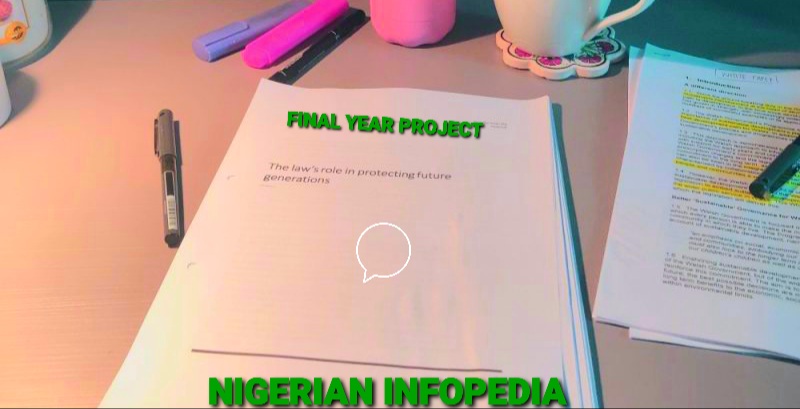How to Write Final Year Project in Nigeria (2026)
Typically, schools and departments in Nigerian universities normally require that students undertake a research project during their last year in the university. However, you would be required to write a project before being able to start the clearing. It’s easier than most persons realize to write a project proposal.

Unfortunately, a lot of students struggle with project writing, adding stress to an already difficult task. Choosing a subject for your final project is usually the most challenging aspect. The other tasks become simpler when you’ve completed this. In this article, the secret to writing a great project will be discussed.
HOW TO WRITE FINAL YEAR PROJECT IN NIGERIA
Detailed information on each of the five chapters should be included in a final year project that is fully researched. The procedures for writing a final-year project in Nigerian universities easily are listed below.
PRELIMINARY PAGES OF THE PROJECT
Here is the first part of your research project. The title of your project, that should not be longer than 23 words, Declaration, Certification, Acknowledgement, Table of Contents, List of Tables, List of Figures (if applicable), and Abstract are all included in the first few pages of a final-year project. Even though the Abstract page is one of the introductory pages, it is typically written only after whole project is finished since it needs to provide a concise explanation of the studies that have been done, the methodology used in the study, as well as the outcomes of the study and any recommendations.
CHAPTER ONE: BACKGROUND OF THE STUDY
Each final-year project begins with Chapter 1. In essence, this chapter serves as an introduction to the research. These are only a few of the parts that make up this chapter:
- The “Background of the Study” puts the subject being examined in context by including current knowledge and pertinent history.
- The “Statement of the Problem” is a succinct explanation of a problem that needs to be fixed or addressed. An effective research question should fill a knowledge gap.
- The “Research Objectives” succinctly state what the study is seeking to accomplish and what the researcher wants to accomplish through the study. There are both broad and specialized objectives.
- “Research Questions” are questions that can be answered about a particular problem or concern. These are the inquiries that the research effort seeks to address. The fact that the study question and research objectives line up is crucial to note.
- A “research hypothesis” is a precise, verifiable hypothesis or prediction regarding the likely outcome of a scientific research endeavor. All that is needed to start a research study is the null hypothesis.
- The “Purpose of the Study” explains to the reader how well the research project will add to the body of knowledge, identifies the beneficiaries, and describes how they will profit from the research’s findings.
- The term “Scope of the Study” precisely describes the subject matter examined in the study. In the case of time-series data, it might also list the variables used and the year the study was conducted.
CHAPTER TWO: LITERATURE REVIEW
The Preamble in Chapter Two outlines the idea of the research project and is followed by Conceptual Review, Theoretical Review, and Empirical Review. The brief preamble of the research project is followed by the Conceptual Review, a section of Chapter Two that collects all justifications for the investigation in a logical sequence.
Theoretical Review is concerned with one or even more existing theories from the recent history that offer justifications for the in concern research investigation. On the other perspective, an empirical review entails a critical analysis of the academic or literary works that have already been published on the subject of the study. In-text citations to the cited sources must be used by the researcher. In order to support his or her research study, the researcher should point out any gaps in the body of literature that have been observed in the writings of authors and other researchers. Academic writing or articles from recognized journals has to be the form of literature acceptable for evaluation in Chapter 2.
CHAPTER THREE: METHODOLOGY OF FINAL YEAR PROJECT
The methods and techniques used throughout the study are covered in this chapter. Typically, Chapter Three is broken into the following sections:
- The kind of design the researcher opts to utilize is described in the section under “Research Design,” along with the rationale behind it.
- The complete list of respondents who constitute the research study is included in the section titled “Population of the Study.”
- The researcher specifies the numbers of interviewees from the overall population who will be used for the project in the section titled “Sample and Sampling Technique.”
- The researcher specifies the kind of tool used to obtain data for the study in the section under “Instrument for Data Collection.” This contains, among other things, surveys, interview schedules, official documents, and rating systems.
- The reliability of the research instrument employed for the study is described in the chapter three section on instrument validity.
- How data collecting for the study was carried out is described in depth in the section under “Procedure for Data Collection.”
- The researcher explains the kind of statistical tools used in the analysis of the data acquired from the study in the section titled “Method of Data Analysis,” along with the rationale for doing so. In addition to many others, SPSS, chi-square, standard deviation, analysis of variance (ANOVA), pie charts, and t-tests are among the statistical techniques frequently used to examine data.
CHAPTER FOUR: RESULT OF FINDINGS
The researcher presents the study’s results in Chapter Four in a comprehensive way, which aids in the justification of any results. In this section, the research questions from Chapter 1 are addressed, and the hypotheses are pushed to the limit to see if the accurate predictions were correct or incorrect.
The key findings from the study’s data analysis should be enumerated and explained in detail. An introduction such, “Based on the examination of data the following discoveries emerged:” should come before presenting the results.
CHAPTER FIVE: DISCUSSION, CONCLUSION, AND RECOMMENDATIONS
The researcher can now describe the results, make inferences, and provide answers to the difficulties that motivated the study. The researcher is obliged to discuss the project’s practical consequences for their field in this chapter.
There should be a section called “Conclusion” in which the researcher encapsulates the main points of their research. Additionally, the researcher must make suggestions based on the project’s discoveries.
REFERENCES
Academic research projects at higher institutions in Nigeria are advised to follow the APA style of reference. Additionally, all charts, graphs, figures, and references must be mentioned. Plagiarism must be prevented at all costs to avoid your project supervisor canceling your paper.
We wish you a successful project defense and graduation.

